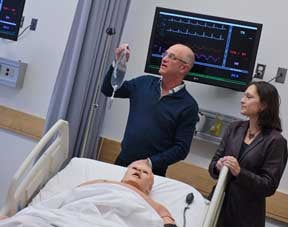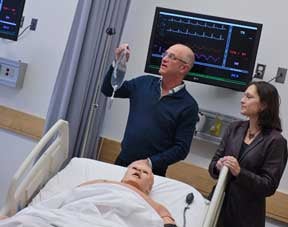 KINGSTON, R.I. – March 27, 2014 – Step into the CVS Caremark Interdisciplinary Health Delivery Laboratory at the University of Rhode Island’s College of Pharmacy, and be prepared for the unexpected as teaching and learning tools virtually come to life. They breathe, they blink, and they have heartbeats. Some of them even bleed. Are they having trouble breathing? Secure the airway and breathe for them. Do they look like they’re getting sick? Administer a medication that will ease their symptoms.
KINGSTON, R.I. – March 27, 2014 – Step into the CVS Caremark Interdisciplinary Health Delivery Laboratory at the University of Rhode Island’s College of Pharmacy, and be prepared for the unexpected as teaching and learning tools virtually come to life. They breathe, they blink, and they have heartbeats. Some of them even bleed. Are they having trouble breathing? Secure the airway and breathe for them. Do they look like they’re getting sick? Administer a medication that will ease their symptoms.
Give them the wrong medication or dosage, though, and the patient could get worse or not survive. They’re called human patient simulators — mannequins with anatomically correct features, realistic skin-feel, and the ability to deliver high-quality and accurate responses to a variety of medical situations and emergencies. URI students work with four adult mannequins, two child-size units, and one baby. The College of Pharmacy expects the simulators will open up a world of educational possibilities to their student pharmacists.
“Many incoming students think that when they graduate, they’ll be going to a local pharmacy and dispensing prescriptions,” said clinical instructor of pharmacy practice and co-director of the lab, Amanda DeAngelis-Chichester. “As the students advance in their education, they realize that the pharmacist plays a critical role on medical teams in hospitals as well as the community. It’s important for students to see how medications are used in the clinical setting.”
“By the end of the simulation portion of the curriculum, students should be able to run their own patient case,” agrees professor and co-director of the lab, Clinton Chichester III. In preparation for that collaboration, the simulation lab is open to students in other academic disciplines as well. Students from several disciplines including nursing, communicative disorders, kinesiology and physical therapy use the lab, as do URI emergency medical technicians.
The first simulator came to URI 15 years ago, thanks to a grant from the Champlin Foundations. Since then, the College of Pharmacy has expanded and developed a curriculum that includes use of multiple simulators. The college has also entered into a program with the URI College of Nursing that allows both colleges to get funding for simulators, with half going to nursing and half to pharmacy. Chichester and DeAngelis-Chichester only see the College of Pharmacy’s use of the simulators growing.
“We’ve been able to break down a lot of barriers since we received the first simulator,” said Chichester. “We’re still working to get this way of learning to be accepted as a standard, but we’ve come a long way.”
“The students are agents of change,” agrees DeAngelis-Chichester. “The majority have seen a steady increase in their skills since participating in the simulation lab. We try to incorporate situations that the students will relate to, and that means listening to the students to find out how they learn.”
Chichester and DeAngelis-Chichester are seasoned faculty in the College of Pharmacy, and they don’t plan to slow down their work with the simulators anytime soon. “We’ve come so far, and there is still so much to do,” said DeAngelis-Chichester. “We know our students want more time in the lab, and we’re trying to give it to them. We take the feedback we get very seriously.”
“It’s about changing the mindset, and the way that the students learn the material,” said Chichester. “We know that this way of learning leads to better retention of knowledge, and more developed skills. We know that we just need to keep moving forward.”
Pictured above STATE OF THE ART PATIENT SIMULATION LAB: Inside the CVS Caremark Interdisciplinary Health Delivery Laboratory at URI’s College of Pharmacy, co-directors of the lab, Amanda DeAngelis-Chichester and Pharmacy Professor Clinton Chichester III, demonstrate how intravenous medications can be used with a mannequin. URI Photo by Joe Giblin.

